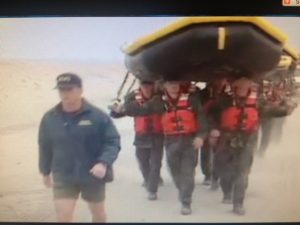So you’re curious about the Navy SEAL training program? Well, buckle up. You’re in for a deep dive into one of the most brutal military programs. By reading on, you’ll get the lowdown on what it takes to earn that prestigious Trident—toughness like no other and skills sharp as knives.
You’ll see firsthand how Hell Week pushes candidates to their limits and why most drop before they finish. But it’s not just physical grit; we’re talking mental severe steel too.
And if you stick with me, I’ll walk you through the elite skills these warriors master—from handling high-tech weapons to sneaky demolitions—and how simulations prep them for real-world missions. Ready? Let’s jump in!
Navy SEAL Training Program Table of Contents:
- The Rigorous Journey of Becoming a Navy SEAL
- Physical and Mental Demands of SEAL Training
- Specialized Skills Acquired During Training
- The Role of Simulation in SEAL Training
- Post-Graduation Assignments and Career Pathways
- The Evolution of Navy SEAL Training Over Time
- Nutrition and Recovery Strategies During Training
- Women in Navy SEAL Training
- Comparing Global Special Forces Training Regimens
- FAQs in Relation to Navy Seal Training
- Conclusion
The Rigorous Journey of Becoming a Navy SEAL
Earning the coveted Trident isn’t for the faint-hearted; it’s an epic saga of grit and resilience. Picture this: three phases will push you to your limits, each crafted to test your mettle in ways you can’t even imagine.
The Phases of SEAL Training
It all starts with Basic Underwater Demolition/SEAL (BUD/S) training, where candidates are put through their paces on land and sea. You’ll find yourself grinding past what you thought were your limits during Hell Week, a notorious stretch known for its relentless physical demands.
Remember, about 75-80% don’t make it through BUD/S—a testament to how tough this gig is. But those who do emerge more brutal, ready for anything thrown their way.
Hell Week: The Ultimate Test of Endurance
Hell Week—it’s not called that because it’s easy. Here, trainees get a real taste of sleep deprivation while tackling physically grueling tasks non-stop. This intense trial separates the committed from the rest—imagine being pushed beyond exhaustion only to realize the tank isn’t empty yet after all.
Physical and Mental Demands of SEAL Training
Becoming a Navy SEAL is an immense challenge, demanding physical and mental fortitude. It’s like trying to climb Mount Everest barefoot, but it’s miles of sandy beaches and freezing ocean waters instead of cold snow.
The SEAL Physical Screening Test
To even start this journey, you’ve got to ace the SEAL Physical Screening Test. Picture this: swimming 500 yards in under 12.5 minutes—that’s half as long as an episode of your favorite sitcom. Warm-up done; now for the push-ups, sit-ups, pull-ups, and a mile-and-a-half run.
Building Mental Toughness
Mental grit? Crucial. You’ll need mental muscles that Arnold Schwarzenegger would envy because physical prowess alone won’t cut it when you’re knee-deep in mud during Hell Week—where sleep is nothing but a fleeting dream.
Imagine keeping sharp while carrying logs with your squad or navigating back-breaking obstacle courses. That kind of grit doesn’t come easy; it’s forged through relentless training designed to weed out those who can’t handle extreme stress without batting an eye.

Specialized Skills Acquired During Training
The expertise of Navy SEALs is acquired through extensive training, honing more than a dozen specialized skill areas. They undergo rigorous training to master more than a dozen specialized skill areas.
Advanced Weapons and Tactics Proficiency
Becoming adept with an arsenal of weaponry isn’t just about pulling triggers; it’s about understanding the mechanics behind each firearm and employing them strategically. SEALs learn how and when to shoot, blending stealth with raw power. The level of combat tactics they grasp is akin to turning recruits into chess masters on a battlefield where every move could be checkmate.
Their proficiency extends beyond guns; SEALs become tacticians capable of engaging targets from land, sea, or air—adapting instantly as missions evolve.
Demolitions and Breaching Techniques
To disrupt enemy operations or gain access during hostage rescues, SEALs get down and dirty with explosives—a mixology class where recipes have dire consequences if not followed meticulously. But there’s art in demolition, too: knowing exactly where to place charges requires scientific precision and intuitive guesswork.
This knowledge lets them breach doors without knocking or create diversions that change the rules of engagement—turning walls into doorways at will.
The Role of Simulation in SEAL Training
Imagine a video game that’s not just pixels on a screen but your gateway to becoming one of the most elite warriors on the planet. That’s kind of what simulations are like for Navy SEALs-in-training. These aren’t your run-of-the-mill Call of Duty sessions; they’re sophisticated setups where every decision could mean life or death in virtual high-stakes scenarios.
In these intense simulations, candidates face situations mirroring real-world missions with such authenticity it blurs the lines between training and actual combat. This level of realism helps hone their strategic thinking and operational planning before stepping onto an actual battlefield.
A significant chunk of later-stage SEAL training is dedicated to these simulated operations—because when you finally hit the ground running (or swimming), there’s no room for error, only excellence.
Post-Graduation Assignments and Career Pathways
The moment a SEAL earns their Trident, the real work begins. Newly minted graduates of one of the most arduous training regimens are primed to take on even more demanding duties.
Team Deployment and Specialization
Gaining entry into this exclusive group requires more than just a title; it’s about discovering where you fit in the team. With eight active SEAL Teams, each boasting six platoons, new SEALs have plenty of room to grow into specialists. They might become snipers with eyes like hawks or tech experts who can turn anything with wires into an asset. Some dive deep as combat swimmers while others take to the skies—there’s no limit when you’re part of this crew.
Diving into missions ranging from covert surveillance to high-stakes counterterrorism operations, they’ll apply every hard-earned skill from BUD/S training in dynamic environments across the globe. It’s not just the strength they bring to the table but adaptability and strategic thinking sharpened by challenges few dare face.
And let’s not forget language skills—a Navy SEAL fluent in foreign tongues is worth their weight in gold on today’s complex battlefield where understanding whispers can mean mission success or failure.
The Evolution of Navy SEAL Training Over Time
Like a blade that gets sharper with each forge, Navy SEAL training has undergone some severe honing since World War II. Back then, it was all about physical prowess and grit—think long runs on the beach and obstacle courses designed by sadists. But as warfare tactics got more brilliant, so did the training.
Adapting to Modern Warfare Needs
Navy SEALs today are more than just muscle; they’re tech-savvy warriors who can drop into enemy territory undetected and communicate with satellites whizzing overhead. The gear’s gotten an upgrade, too—we’re talking night-vision goggles that turn midnight into high noon and drones that scout ahead without risking lives.
The changes aren’t just cool gadgets, though. They’ve transformed what it means to be combat-ready. Now, candidates must understand cyber security principles almost as well as how to parachute from a plane at 30,000 feet—because sometimes pulling out your knife won’t cut it anymore when you need to disable an enemy server instead of a sentry.
This shift isn’t surprising given how much Navy SEAL operations have evolved—from storming beaches during D-Day landings to taking down high-value targets in urban environments where precision is key for mission success—and collateral damage must be minimized at all costs.
Nutrition and Recovery Strategies During Training
Visualize yourself pushing your body to its utmost limit, day after day. Without the proper nutrition, your training efforts will be in vain. SEAL candidates know this all too well; they rely on nutritionists like pit crew members tuning a racecar for peak performance.
The training is tough—no doubt about that—but eating smart can make or break your success at BUD/S. It’s not just chow down on protein and call it a day; these guys need a diet optimized for recovery, endurance, and strength building. We’re talking complex carbs for long-lasting energy during those brutal obstacle courses and lean proteins to repair muscles after ‘welcome-to-the-suck’ workouts.
And let’s not forget hydration—because when Hell Week rolls around, staying hydrated could mean the difference between ringing that bell (not good) or sporting that coveted Trident (very good). With Nutritionists keeping an eagle eye on their diets, they help each candidate fine-tune their food intake, ensuring every calorie counts towards becoming an elite warrior of the sea.
Women in Navy SEAL Training
Since 2016, the grueling world of Navy SEAL training has been open to women, breaking barriers and setting new standards within military ranks. Integrating into this elite brotherhood is no small feat; it requires surpassing incredibly high physical and mental benchmarks that many aspire to, but few achieve.
The journey begins with meeting the same demanding criteria as their male counterparts—swimming 500 yards in under 12.5 minutes, for instance—is just one piece of a larger puzzle designed to test the limits of human endurance. Despite these rigorous demands, female candidates stand poised at the starting line, ready to carve out their place in history.
For those who persevere and conquer the rigorous challenges of BUD/S training, their success inspires others, exemplifying what can be achieved through sheer determination. For those exceptional women who rise through the ranks and emerge victorious from BUD/S training, they not only earn their Trident but also redefine what’s possible for future generations looking up at them as role models—and rightly so.
Comparing Global Special Forces Training Regimens
Navy SEAL training is legendary for its intensity, but how does it stack against the British SAS? The Brits don’t mess around either; their selection process is a beast in its own right. Candidates are pushed to their limits with endurance marches, jungle treks, and interrogation resistance while running on minimal food and sleep.
Now let’s talk stats—SEAL hopefuls face an attrition rate that hovers between 75-80%, which says plenty about the sheer grit required to get through. Meanwhile, across the pond, SAS candidates endure similar dropout rates. It’s like comparing two heavyweight fighters at the top of their game: different styles but equally formidable.
The U.S. Navy SEALs’ Hell Week is infamous—a brutal five-and-a-half-day stretch where sleep is a mere luxury and quitting seems like a sweet release. On this side of the Atlantic, though, we’re not alone in our hardcore ways—the SAS has its ‘Test Week’, four back-to-back days of non-stop physical punishment designed to sift out all but the toughest nuts.
Navy SEAL Training Program Conclusion
Navy SEAL training is a crucible, no doubt about it. It tests every limit—physical, mental, and emotional.
Remember the grit needed to tackle Hell Week? That’s just the beginning. These warriors need endurance like iron and wills of steel.
Mental toughness comes next; without it, even the strongest falter. But those who push through become masters in combat tactics and weaponry.
Simulations prepare them for chaos on actual missions; this ensures they’re ready for anything thrown their way. And let’s not forget nutrition—it fuels these intense feats of strength.
The journey to earn that Trident is monumental, but remember: with enough resilience, you too can conquer Navy SEAL training.
